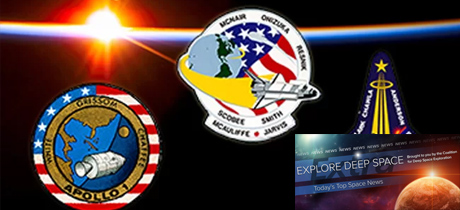In Today’s Deep Space Extra… This week marks the anniversary of three NASA tragedies, the January 27, 1967 Apollo 1 fire that claimed three lives, the January 28, 1986 shuttle Challenger loss in which seven fliers perished and the February 1, 2003 loss of the shuttle Columbia with the loss of seven crew members. A record partial U.S. government shutdown that furloughed an estimated 800,000 workers or called upon them to work without pay at federal agencies, including NASA and NOAA has ended. But concerns remain Washington may not settle differences over immigration policies by a February 15 deadline.
Human Space Exploration
‘Isn’t that enough?’ Remembering Grissom, White and Chaffee, fallen crew of Apollo 1
AmericaSpace.com (1/27): Sunday marked the anniversary of another space tragedy, the January 27, 1967 launch pad fire in which Apollo 1 NASA astronauts Gus Grissom, Ed White and Roger Chaffee perished while preparing for the first orbital test flight of the Apollo spacecraft from Cape Canaveral, Florida, with crew. Grissom was the second American in space, White the first American to conduct a spacewalk. Chaffee, a promising young astronaut, was preparing for his first trip to space.
Son of space shuttle Challenger commander remembers tragedy 33 years ago
CNN (1/27): U.S. Air Force Lt. Gen. Richard Scobee recalls the loss of his father, NASA astronaut and shuttle Challenger commander Dick Scobee, who perished along with six others on January 28, 1986 after lifting off from NASA’s Kennedy Space Center (KSC). “Everyone saw how my father died and they saw the end of his career,” his son said. “What they didn’t see was his life — which was amazing.” Those also lost aboard Challenger were pilot Mike Smith, Ron McNair, Ellison Onizuka, Judy Resnik, Hughes Aircraft payload specialist Greg Jarvis and New Hampshire school teacher Christa McAuliffe.
To the stars: This week we remember two shuttle disasters
Texarkana Gazette (1/27): This week marks the anniversaries of two tragedies in the U.S. space shuttle program. On January 28, 1986—33 years ago today—The NASA Space Shuttle Challenger broke apart just 73 seconds after liftoff. On Feb. 1, 2003—16 years ago this week—Columbia was re-entering the Earth’s atmosphere over East Texas when hot gases were able to enter the wing through a small hole created by the foam. The gases destroyed the wing structure—and caused the shuttle to break up in the sky.
End to shutdown near, but might be temporary
Spacepolicyonline.com (1/25): Parts of the U.S. government, including NASA and NOAA will re-open through February 15, under the terms of a budget agreement reached by the House and Senate and signed off on by President Trump late Friday. The action ended a partial shutdown that began December 22, affecting an estimated 800,000 workers nationwide. The unpopular shutdown could re-emerge if law and policy makers are unable to come to terms on a long term U.S. immigration policy by the middle of next month.
NASA workers relieved but wary as shutdown ends for now
Houston Chronicle (1/26): Workers at NASA’s Johnson Space Center (JSC) in Houston were among those relieved late Friday as the White House and Congress came together to end a record partial U.S. government shutdown underway since December 22 that took an economic toll on households beyond those of a 3,000 member civil servant workforce. Most were furloughed some worked without pay in support of the International Space Station (ISS) and other projects.
Space Science
Ultima Thule revealed in new detail with fresh flyby image
Spaceflightnow.com (1/25): New images transmitted to Earth by NASA’s New Horizons spacecraft moments before it flew close to the Kuiper Belt Object Ultima Thule on New Year’s Day reveals new features on the large snow man shaped object, among them surface fractions and a large crater that may have come from an impact. Also notable is a bright collar where the two spherical objects that form Ultima Thule merged billions of years ago.
Other News
Here’s what Jeff Bezos’ Blue Origin plans for its new Alabama rocket engine plant
Alabama.com (1/25): Kent, Washington, based Blue Origin broke ground Friday in a production plant for its BE-3 and BE-4 rocket engines, rocket power plants that will also be test fired at the nearby NASA Marshall Space Flight Center. Expected to open in 2020, the plant will provide 300-400 new jobs.
Virgin Galactic lays off dozens of employees as it prepares for commercial flights
New Mexico Politics.net (1/25): Virgin Galactic is laying off 43 workers, mostly at production facilities in Mojave, California, as it prepares to initiate commercial suborbital activities including passenger flights from Spaceport America in Las Cruces, New Mexico.
‘Apollo 11’ lands at Sundance with never-before-seen mission footage
Collectspace.com (1/25): The documentary Apollo 11 debuted at last week’s annual Sundance Film Festival. The production traces the Apollo 11 mission, the first human space voyage to reach the surface of another planetary body, the Moon, in July 1969. As the 50th anniversary of the historic mission approaches, the production based on newly surfaced large format film footage and audio recordings, will appear in theaters, museums and science centers this spring and on CNN as the actual anniversary approaches.
Major Space Related Activities for the Week
Major space related activities for the week of January 27 to February 2, 2019
Spacepolicyonline.com (1/27): The record U.S. partial U.S. government shutdown affecting an estimated 800,000 federal employees ended at least temporarily on Friday. The U.S. House and Senate will be in session at least part of the week, with efforts to prevent another shutdown on February 15 on the agenda. A range of civil and military space policy gatherings are also planned.

